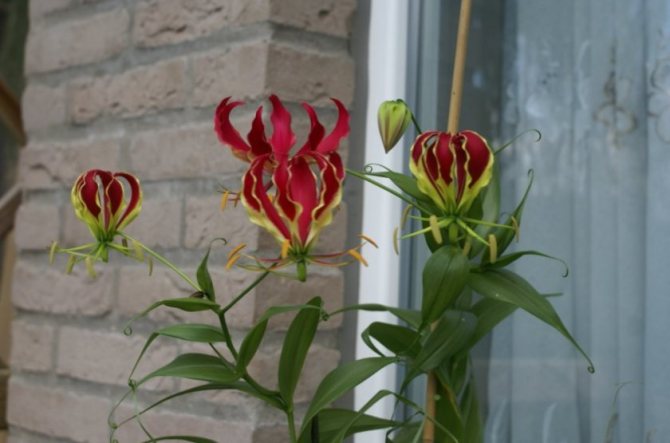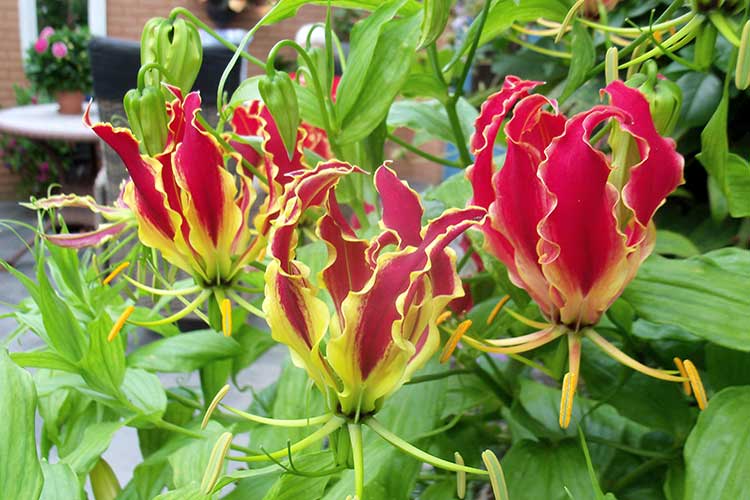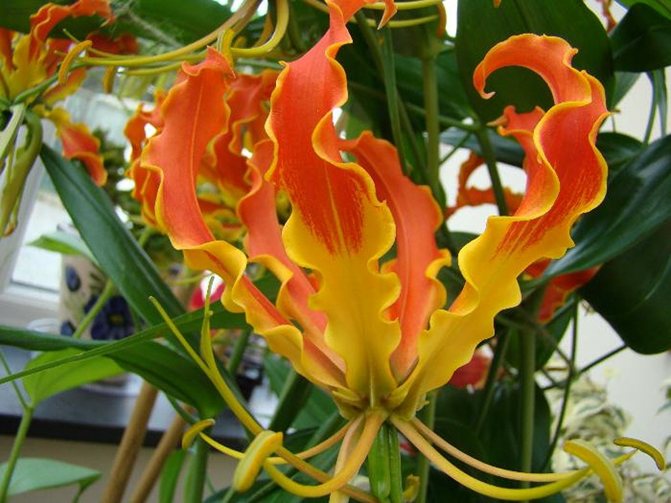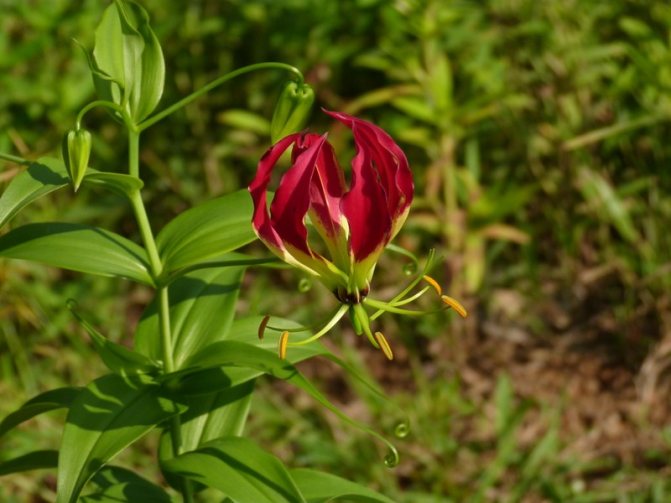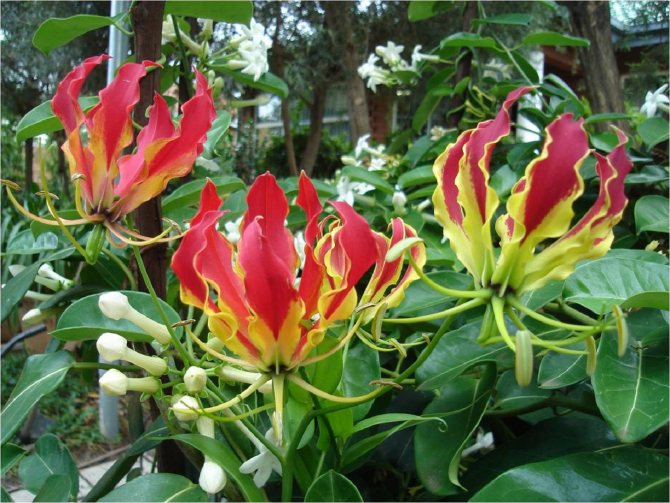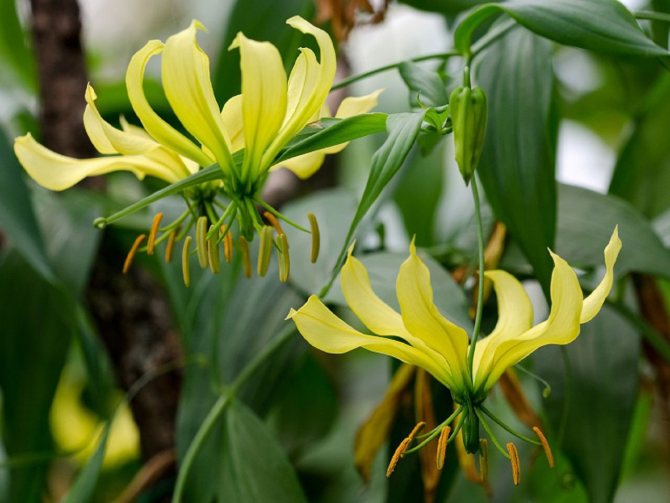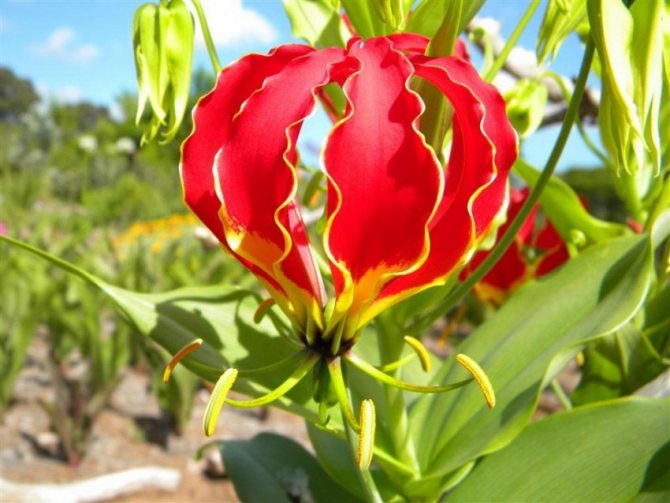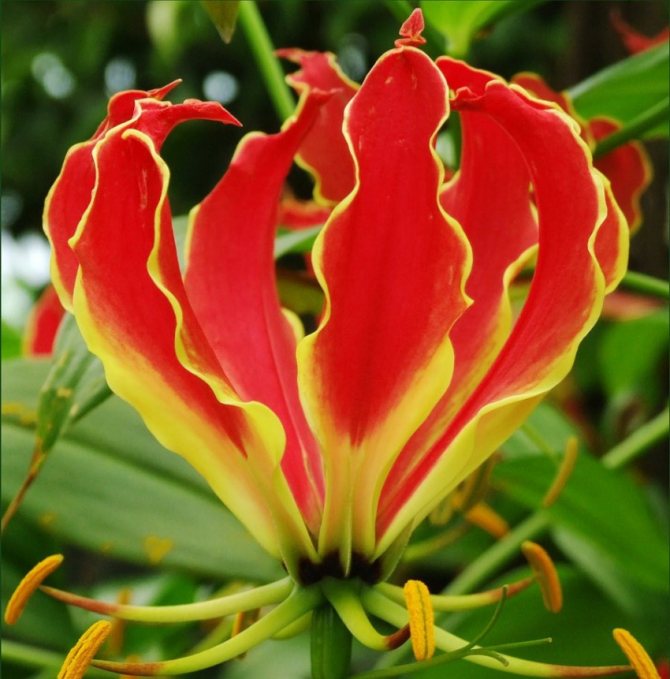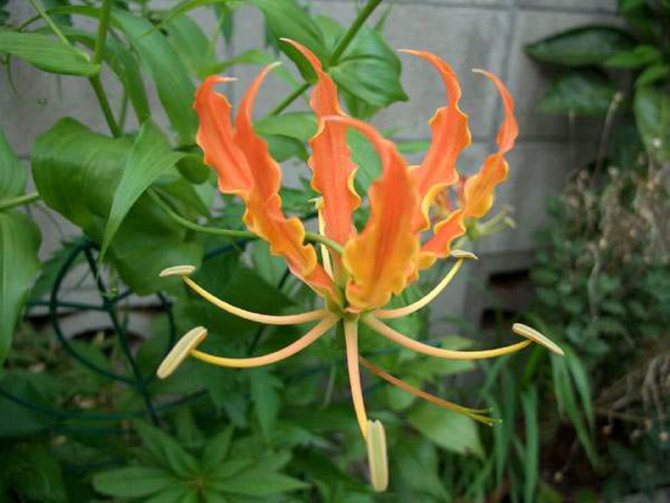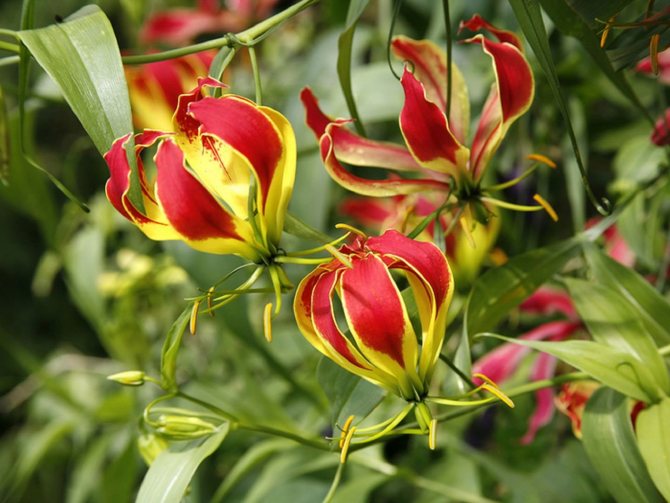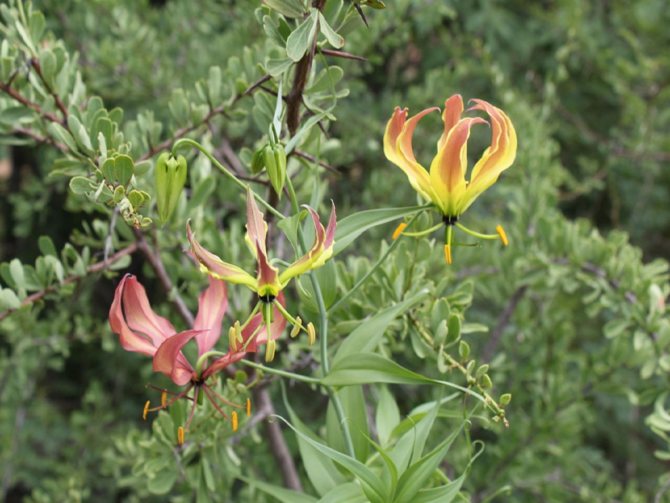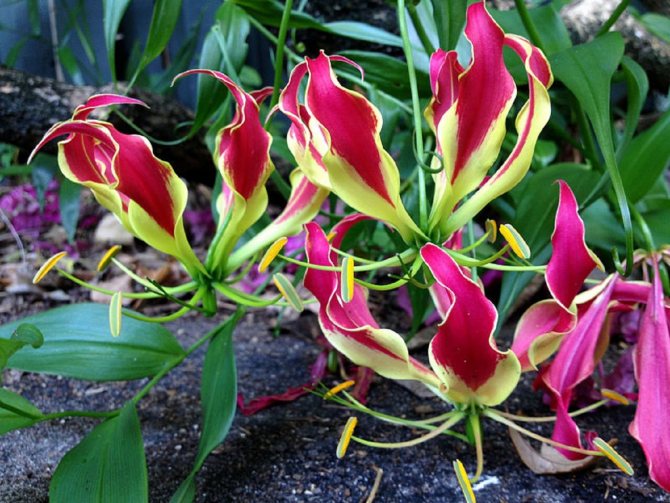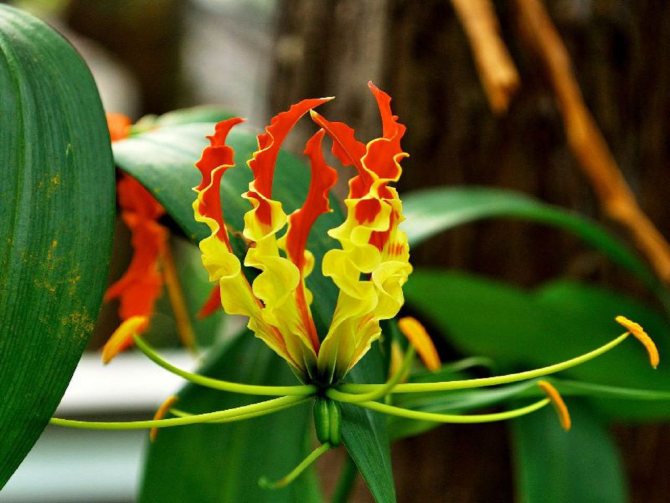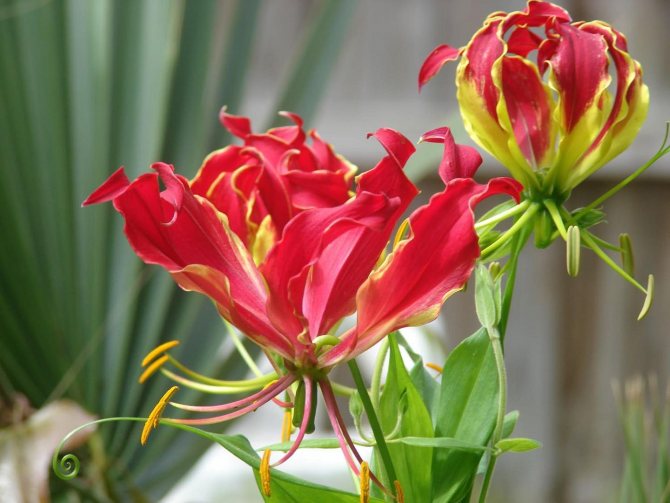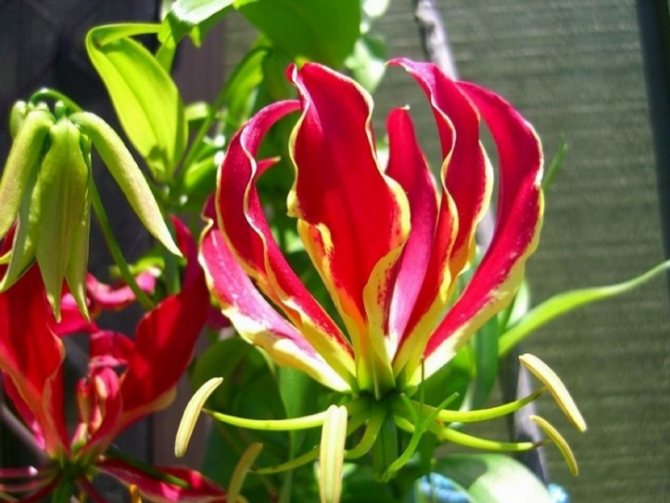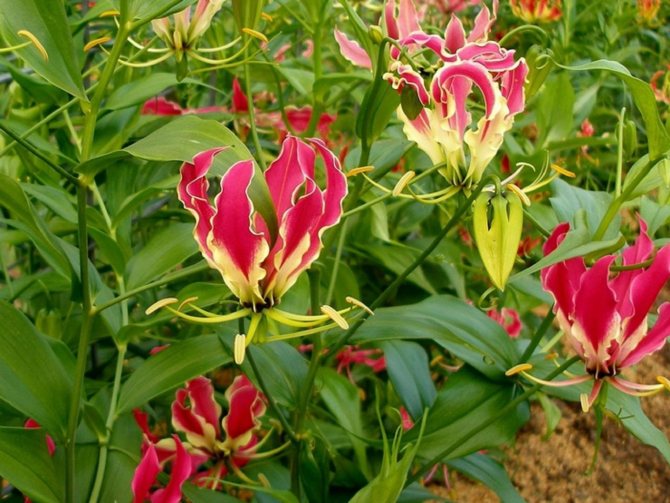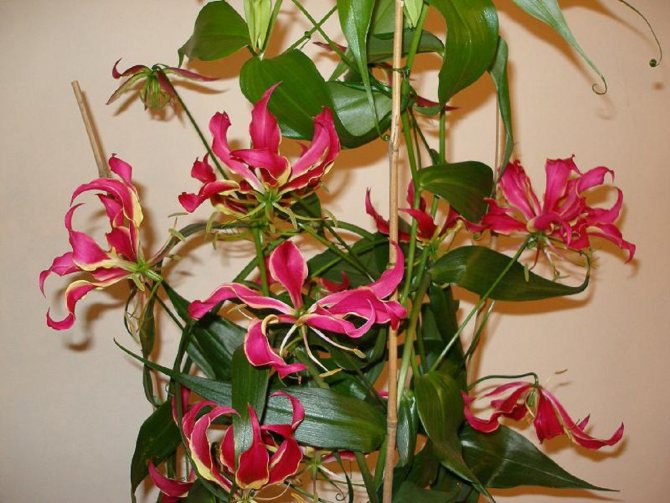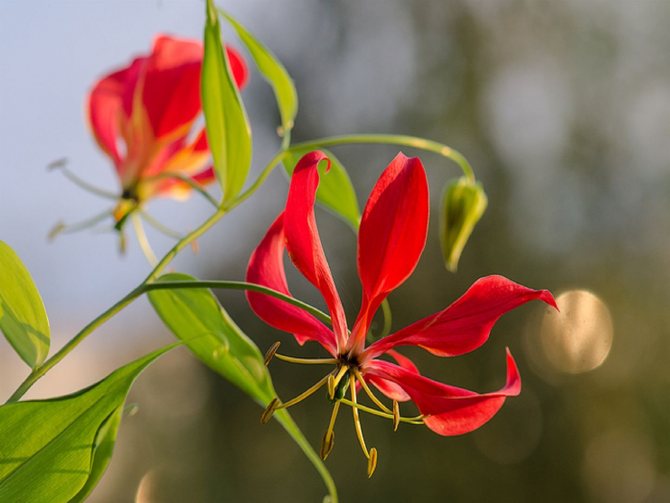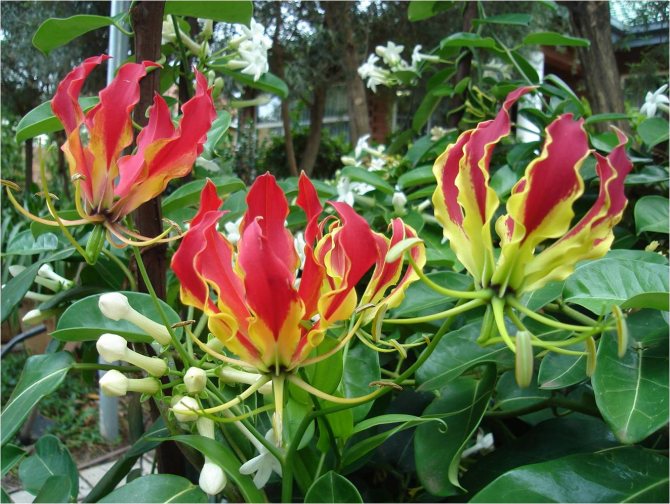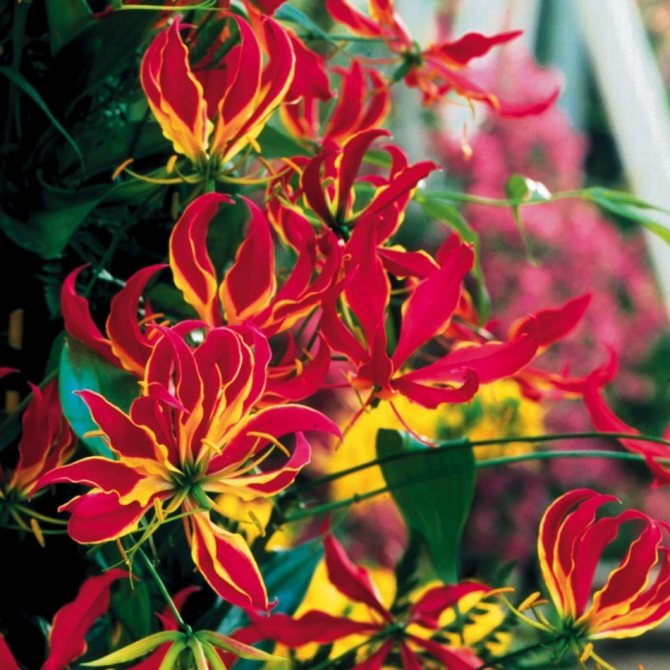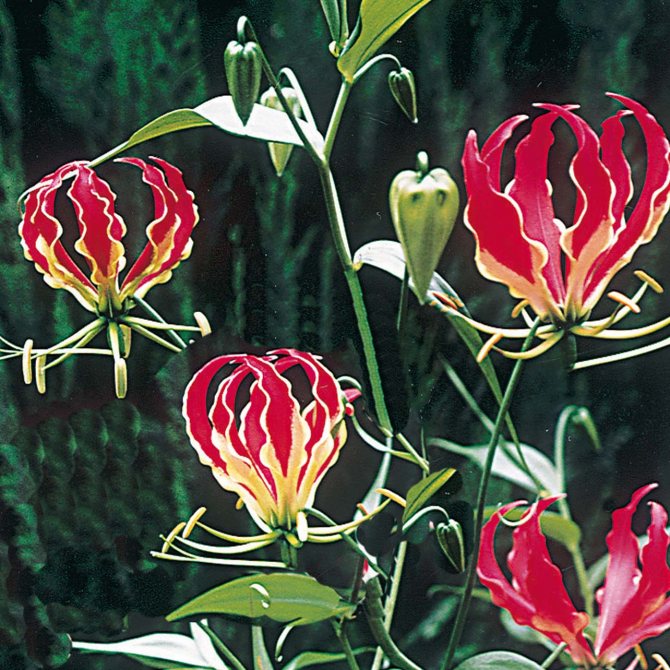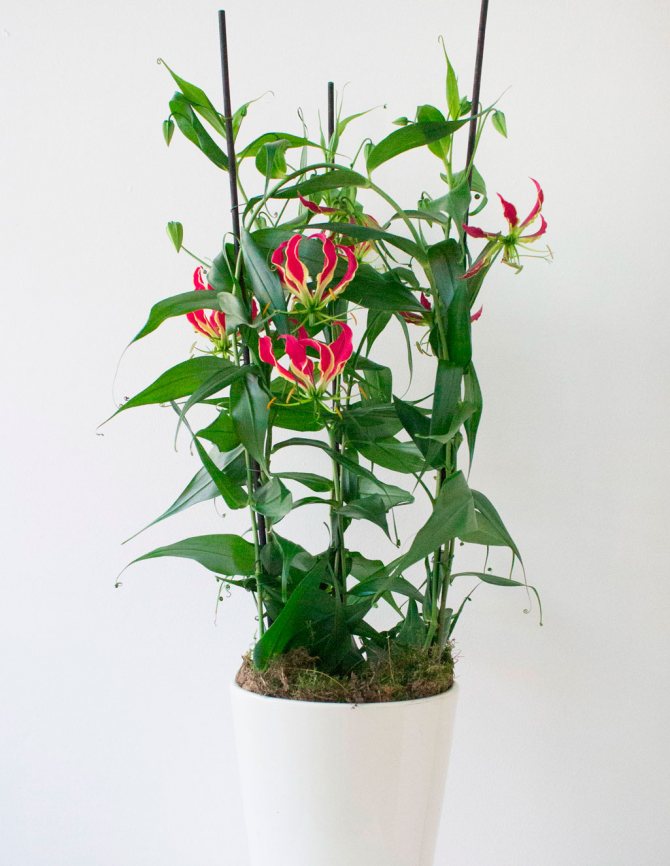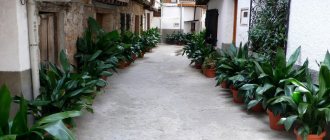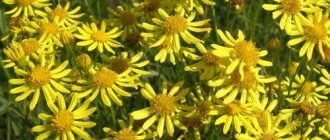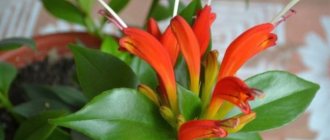We are accustomed to the fact that many indoor plants have, in addition to the official names, and other, "folk" nicknames. Most often, they reflect some important, noticeable property of the flower. Such popular names are rarely bright and catchy. But gloriosa - our current heroine - can boast of proud, majestic, royal nicknames: "flaming lily", "lily of glory"!
Blooming gloriosa can catch the eyes of even the most indifferent person! No wonder, probably, she is the national symbol of the state of Zimbabwe, and nosy journalists have long noticed: the Queen of England often decorates her outfit with a gold brooch depicting this flower. The brooch is expensive, decorated with diamonds, and an ordinary person is too tough. But we can decorate our home with real, live gloriosa! What you need to be able to do - we will now find out.
What is special about this plant?
A bright representative of the melantiev family. The natural habitat climate is tropics. Found in Asia and southern Africa. As a houseplant, gloriosa is grown in countries and regions with cold climates. The name "flower of glory" is often found, derived from the translation of the Latin name.
Grows from tubers. Shoots are thin, long, easily climb on supports, holding on to them with antennae. The leaves are oblong, rich in color. The location is opposite, less often - 3 pieces each. Peduncles appear from the axils of the leaves. Each has 2 flowers. The flowers resemble lilies. Bright orange perianths reach 10 cm. At the edges they are framed with a yellow border.
There is a popular name - "lily of flame". Its flowers gradually turn from yellow to red and, indeed, resemble tongues of flame during a gust of wind. Long-lasting flowering, with good care from spring to autumn. As some bloom, new buds appear. 4-7 buds are formed on each stem.
Important! All plants of the melantium family are poisonous! Ingestion of particles or gloriosa juice causes poisoning, on the skin - irritation. It is recommended to wash your hands after contact with the flower, put it out of the reach of children and pets.
Description of the plant
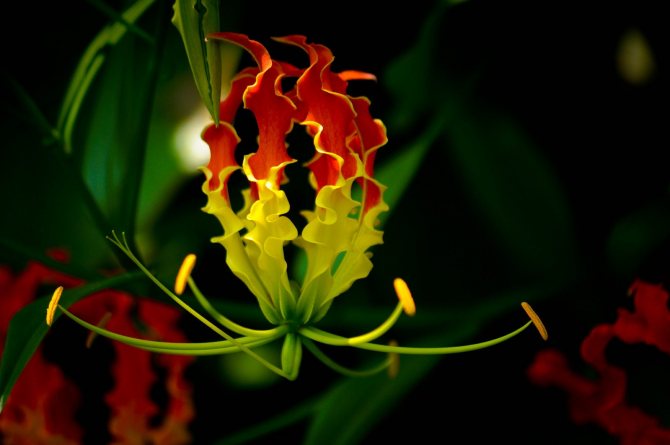
The gloriosa flower is a climbing tuberous plant of the lily family. This spectacular flower is native to the tropical regions of Asia and Africa. The plant has graceful, thin, curly stems that grow from elongated, finger-like or carrot-like tubers. The stems are covered with satin leaves with tendrils at the ends: with their help, the plant clings to the support. Gloriosa leaves are elongated, glossy, colored bright green. From the leaf axils at the tops of the stems, very original single flowers appear, reaching a diameter of up to 12 cm. Outwardly, they look like a "turban", and also resemble lily flowers: large, with sparse long wavy petals curved upward. Flowers are usually painted in two colors.
Popular varieties
All gloriosa varieties are very beautiful. Several varieties are especially popular.
- Gloriosa Rothschild. Curly shoots, highly branched. The leaves are lanceolate. Pedicels are long, flowers are solitary.Petals are fiery red, curly, slightly oblong. The underside of the petals is yellow-red. Differs in a long, stable flowering period.
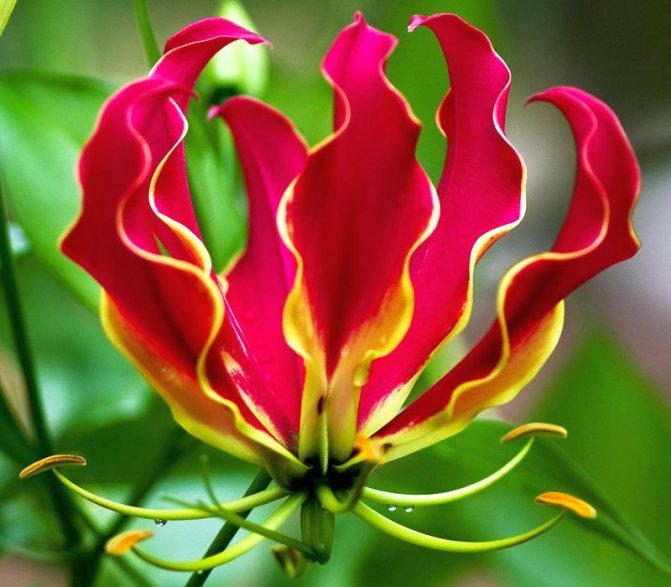

- Gloriosa is simple. The length of the lianas reaches one and a half meters. The leaves are oblong, rather large, pointed at the end. The flower petals are yellow with a greenish tint and beautiful red streaks. Mass bloom in summer.
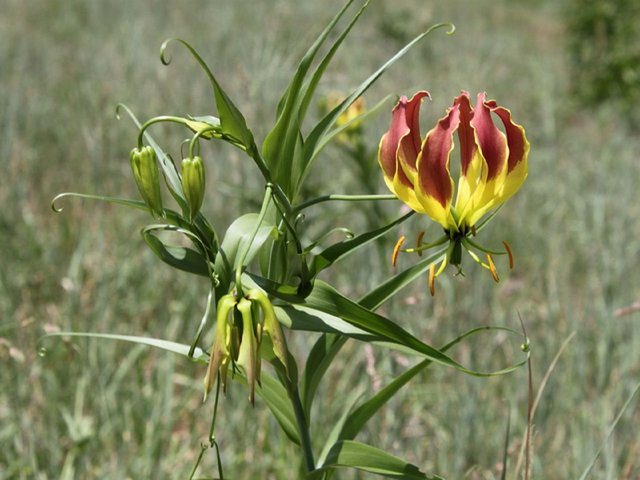

- Gloriosa is great. It is considered the most beautiful and popular variety. Shoots are long - up to 2 m. Leaves are lanceolate, 3 pieces are located on the stem. The flowering period is slightly shorter than that of most varieties. It can often be found under the name "luxurious gloriosa".
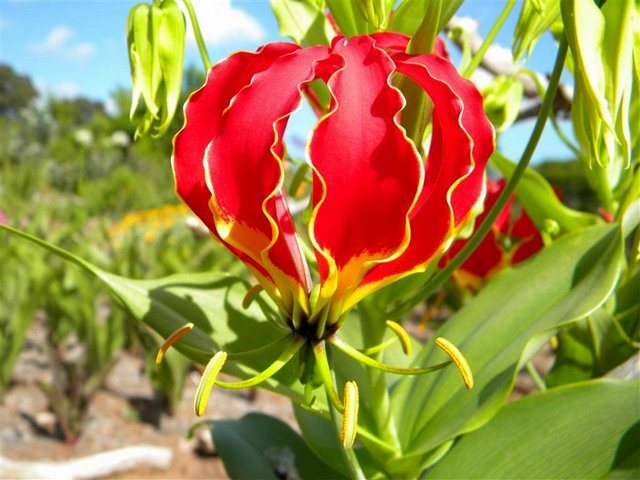

Gloriosa Rothschild photo
Care rules
For beginners, growing and caring for a flower can seem daunting. It is recommended to take into account the characteristics of the plant and adhere to a number of rules.
- Temperature. Heat-loving flower - gloriosa is comfortable at 20-22 ° C during growth and flowering. Temperature drops are undesirable. With the end of flowering, the life cycle of the plant also ends - the aboveground part completely dies off. It is cut off, the tubers are stored.
- Lighting. Optimal - diffused light. It grows well on any windows except the northern one. In the south, on hot days, it is recommended to slightly shade.
- Watering. Water until the soil is completely wetted. Between waterings, wait for the soil surface in the pot to dry out. Yellowing of leaves is a signal to reduce watering. In winter, the tubers are kept dry.
- Top dressing. Liquid products for flowering crops in the dosage specified by the manufacturer.
- Humidity. Within 60-70%. Spray in the morning and evening. Use boiled water. It is recommended to increase the humidity in the room by any means possible. For example, using a special humidifier.
Advice! Experienced growers recommend storing tubers in vermiculite or dry peat. As a last resort, they can be left in the same pot for the winter. But in the spring, the tubers are necessarily transplanted into new soil!
Gloriosa care at home
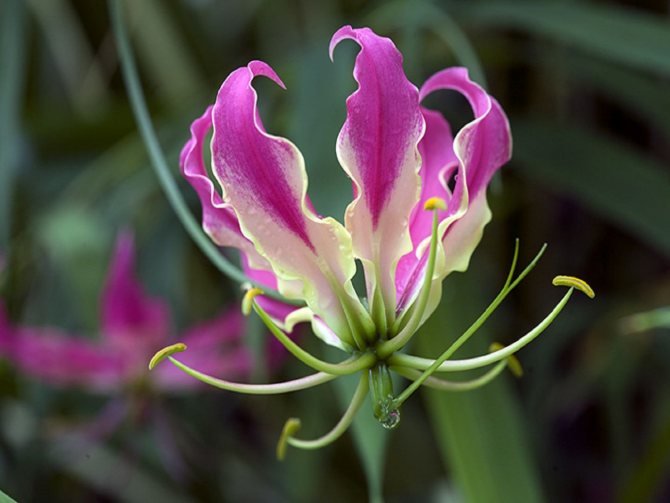

It is best to purchase a plant in specialized stores. For sale, indoor flowers are grown in special greenhouses in conditions of high humidity and air temperature. Without preliminary hardening, the plant most often dies or begins to hurt. In flower shops, cultures go through this procedure and therefore it is easier to tolerate moving and new conditions. The leaves of the selected plant should be healthy, free from pests and signs of disease. The stem is evenly leafy, succulent, with green leaves. Does gloriosa prefer careful or unpretentious care? This question is often asked by novice growers.
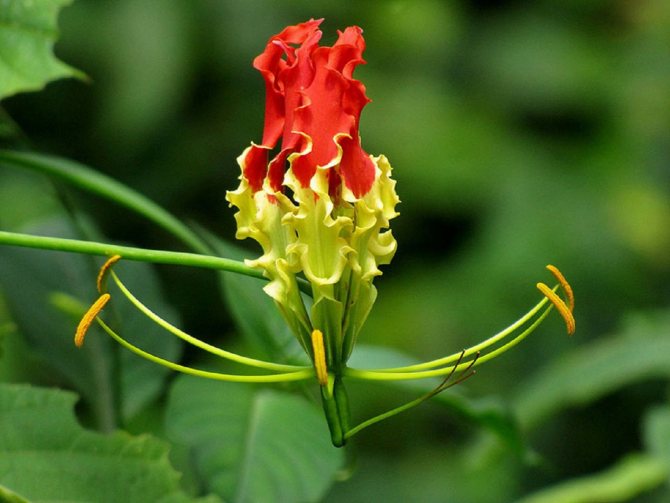

The plant is not capricious, the content of the flower consists in systematic moderate watering of the indoor plant, providing warm diffused light, maintaining a comfortable air temperature.
Annually in the fall, glorious gloriosa suffers the dying off of the aerial part, white-brown rhizomes or long "carrots" remain overwintering in the home greenhouse.
After the shoots die off, in the absence of watering, the roots can be stored at room temperature. In February, luxurious gloriosa tubers are ready for germination.
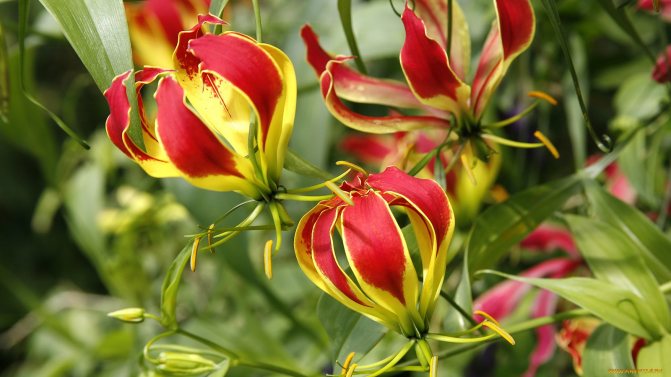

Location and lighting
Lighting is one of the most important factors in the development of indoor crops. Under the influence of sunlight, the process of photosynthesis takes place in the leaves, and if there is insufficient light, they become too pale and dull. However, too intense light can be harmful to the plant. Often it becomes the cause of the appearance of brown and gray spots on the leaves - sunburn.
Each culture has its own requirements for the light regime, and often several species of the same genus may prefer lighting of different intensity.
Gloriosa needs a bright, sunny, warm place.In summer, you need to protect it from direct sunlight, you can take it out into the fresh air, onto a balcony or loggia, and tie the shoots to a support.
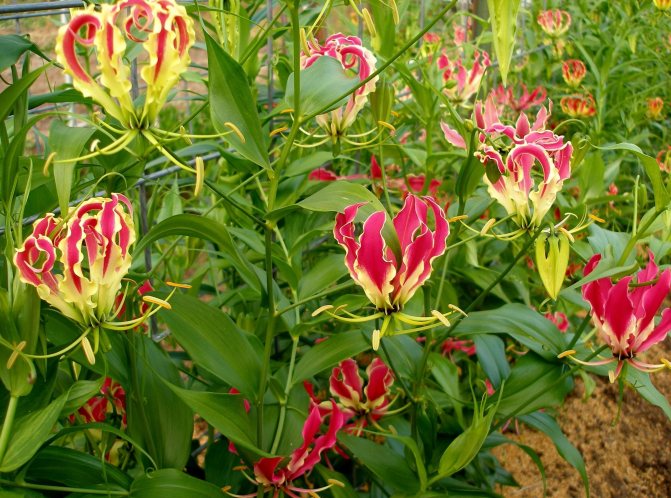

Temperature
In a room where gloriasis develops during the growing season, the temperature must be maintained at least +16 degrees.
Air humidity
Gloriosa needs high air humidity. It is necessary to carefully spray the plant every day, but only so that the water does not come into contact with the flowers, since moisture can provoke the appearance of stains, which will spoil the decorative attractiveness of the culture.
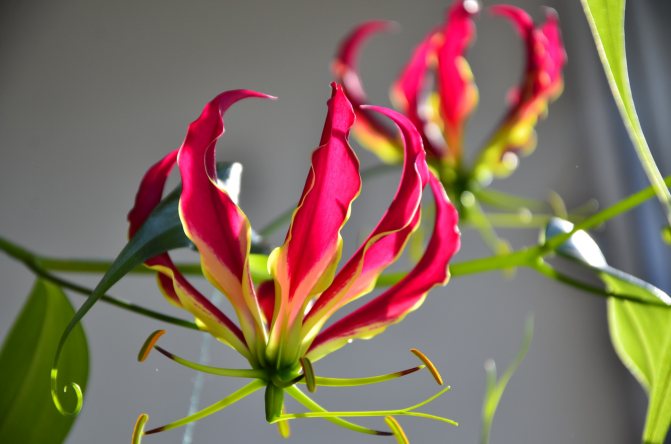

Watering
Without exception, all indoor crops need watering, since without water they inevitably die. Water is of great importance for all vital processes of a plant: photosynthesis, assimilation and movement of mineral substances, temperature regulation. For plants, not only a lack of water, but also an excess of water is destructive.
With too frequent and plentiful watering, the water blocks the access of air to the roots, the latter begin to rot.
In summer, watering should be normal, the soil should remain evenly moist. It cannot be too waterlogged, otherwise the tubers may rot. In autumn, watering is reduced, and after the leaves die off, they stop altogether. When the plant has faded, you should wait until the leaves wilt and fall off. After that, the tuber is left in a pot and kept all winter without watering.
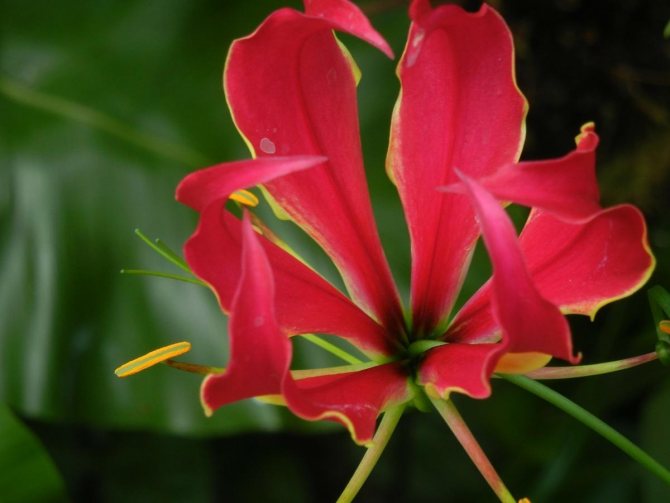

Top dressing and fertilizers
During the period of active growth until late summer, a liquid fertilizer with a high content of potash should be applied every 1-2 weeks.
Garter
The gloriosa flower, as mentioned above, is held on to the support by means of tendrils at the ends of the leaves. The stem is tender, brittle. To avoid breaking the stem, it must be tied up.
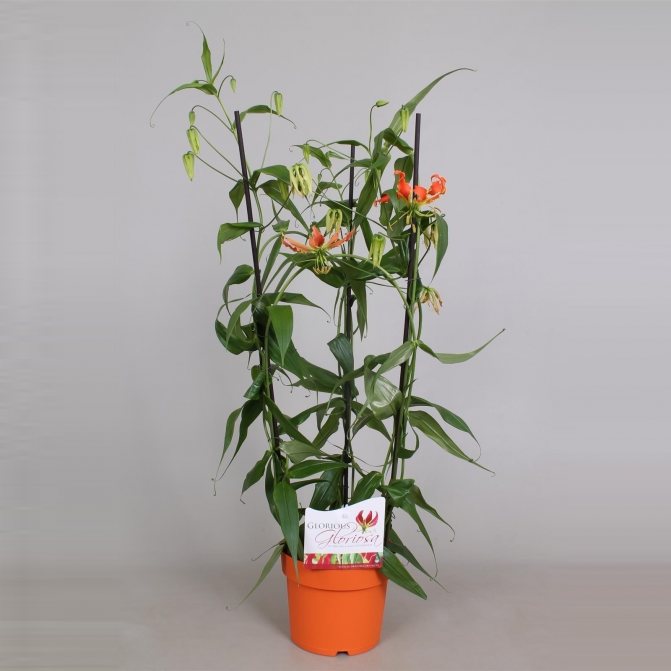

Forming features
Gloriosa is fast growing and has very fragile stems. The right moment of the garter must not be missed - the elongated lashes break easily. The plant is tied to the support regularly, as the lashes grow. Gloriosa has tendrils, but these often do not support the weight of the plant.
A bamboo or plastic grate is used as a support. Install it next to the pot, fix it securely. To create original compositions, non-standard supports are used.
Plucking whips is not practiced. Gloriosa is prone to slight independent branching. If they want to strengthen it, bend the young shoot (70-80 cm) down. Tied up with natural soft materials - jute, woolen yarn.
Temperature
The flower should be kept at 20-25 ° C. This mode is most suitable for the spring-autumn period. This is the time of active plant development. With the beginning of the dormant time, the tuber is dug up, it must be kept in cool conditions at 12-15 ° C.
With the arrival of spring, the plant begins to come to life. Shoots appear on the tuber. Therefore, it is necessary to slowly and smoothly increase the temperature regime. It is impossible to transfer sharply to a warm place or a hot room - this will have a detrimental effect on gloriasis.
Planting and transplanting
Planting and transplanting are the same. The tubers are planted in early February. The pot is used wide up to 35 cm and shallow. The roots of the plant are oblong, in the form of a slingshot. In the pot, the roots are placed with a slight slope, almost horizontally. Make sure that the fork of the slingshot slightly looks up. Sprinkle with earth 3 cm.
When planting, the integrity of the blunt tip of the tuber is monitored. The only point of growth is located on it. Damage to it will render the tuber unusable. If there is damage on the root - scratches, cuts, they are sprinkled with coal powder or sulfur to avoid decay.
Sometimes there is a vertical method of planting in deep pots. Experienced growers oppose him. Long-term drying of a large volume of soil, poor ventilation lead to acidification of the soil and increase the likelihood of root rot.
The soil is used nutritious, loose, slightly acidic.The simplest composition is an equal amount of sand, humus, peat, turf and leafy soil. The addition of shredded pine bark is helpful. Drain at least a third of the pot.
The first accurate watering is after two days. Before sprouts appear, small amounts of water are used, slightly moistening the soil. With the onset of active growth, watered abundantly.
Important! The interval between planting a tuber and its germination depends on the composition of the soil, humidity, temperature. It fluctuates from 3 days to 3 weeks. Clay soils slow down germination. In peat soils, sprouts appear quickly. Humus must be added to the mixture - it excludes soil depletion and the development of chlorosis. You can add 3 tbsp per liter of universal soil mixture. carefully crushed mullein.
Winter rest of gloriosa
Summer has passed, our flaming beauty has faded, and its stem begins to dry a little, and the leaves fall off. Don't let this scare you - the flower is getting ready for winter sleep. Stop watering the plant, and gradually all of its aboveground part will die off. Only the tuber remains in the pot - what to do with it?
There can be two options for action.
- Without touching the tuber, take the pot with it to a dry, preferably cool, place. Room temperature will also work, but it is still preferable to + 16 + 18 degrees. Somewhere in mid-February, carefully remove the tuber from the ground, if necessary, separate the developed children from it, and transplant it into a new ground, as described above. If you are sure that the land is still good, you can not replant at all, but simply start watering. After about a week, new shoots will appear on the surface.
- You can immediately, even in the fall, remove the tuber from the ground, sprinkle it with dry sand or peat and store it in a cold place (even in the refrigerator) at a temperature of +10 to + 14 ° C. At the end of winter, transplant into new soil and start watering little by little.
Important! In this case, the temperature should not be raised immediately, but gradually, otherwise the tuber may die.
When choosing options for winter storage, you should know that with the first of them, shoots appear much earlier than when the tuber was stored in the cold. In the second option, seedlings sometimes do not appear for two months. Be patient, and in no case dig up the planted tuber! You will almost certainly destroy the tiny roots that are forming at this time.
Propagation by tubers and seeds
The plant has daughter nodules. They can be separated from the main one if its weight is more than 10 grams. Small nodules are immediately planted in separate containers up to 15 cm in diameter. They do not deeply deepen - the maximum depth is 2.5 cm. Germination conditions are the same as for adult tubers. Tuber propagation is considered a reliable and effective method.
Gloriosa from seeds at home grows much more slowly, flowering is expected in the third year after planting. Use store-bought seeds or seeds obtained from their plant. Sow in light, moist soil. Cover with foil, keep at 22-25 ° C. Monitor soil moisture. The grown seedlings dive.
Interesting facts about Rothschild gloriasis
Gloriosa Rothschild is known not only for her exotic appearance. There are many interesting facts about this plant:
- gloriosa is native to countries with tropical and humid climates. But this flower is amazing for its ability to adapt to environmental conditions. If there is no rain for a long time, then the flower falls into a kind of "hibernation". As soon as the humidity and temperature reach a comfortable level again, gloriasis wakes up;
- the exotic flower eventually began to spread throughout the world. But for some regions, this has become a real problem. For example, in Australia, gloriosa liked it so much that there it began to spread at an incredible rate, filling a huge amount of land and displacing other crops. In this country, gloriasis began to be dealt with as an aggressive weed;
- the fragile and exotic "appearance" of Rothschild's gloriosa is very deceiving. Few people know, but all the aboveground and underground parts of the plant contain the alkaloid colchicine - a rather dangerous poison. The highest concentration of this substance is found in the seeds and in the rhizome of the plant. If your young children are not averse to trying the taste of indoor flowers, then by no means grow Rothschild gloriosa at home. Pets can also suffer from this ornamental plant;
- Gloriosa Rothschild has earned great popularity among Indian healers. In India, this ornamental plant is grown for the preparation of various decoctions, infusions according to old recipes of traditional medicine;
- the poisonous nature of Rothschild's gloriosa made this plant popular even in ancient times. The natives were looking for bright flowers for that. to extract poison from tubers and moisten arrows with it;
- Gloriosa Rothschild is a good gift option for a man. Since ancient times, it was believed that a flower will bring good luck to a warrior if he takes it with him to the battlefield;
- Gloriosa Rothschild became famous in Europe thanks to one interesting story. Elizabeth II during one of her trips to Southern Rhodesia was presented with a memorable gift - a brooch in the form of a bright gloriosa flower;
- in some regions of Thailand and India, gloriosa is such a revered plant that it was even made part of the state emblem. Zimbabweans have also made gloriosa their national flower.
Possible problems
Gloriosa is not the easiest vine to grow. Failure to comply with the care regimen, storage of tubers is harmful to the plant.
| Problem | The reasons |
| Slow growth and lack of flowering | Storage of tubers in the cold, damage, stem fracture. |
| Slower growth of shoots, darkening, drooping of leaves | Temperature jumps, excessive watering, stagnant water in the pot. |
| Browning or yellowing of leaves at the tips | Dry air and poor watering. |
| Sluggish, soft stems, yellowing of leaves at the base | Possibly root rot as a result of poor drainage, excessive watering, low temperatures, and a large volume of soil. |
It is infrequently affected by pests. Sometimes a scale insect or aphid can "migrate" from neighboring plants. It is recommended to deal with them with solutions of the preparations "Aktara" and "Confidor". In fact, growing gloriosa is tricky, but not as difficult as it might seem at first glance. All the subtleties of care can be mastered in one season.
Diseases and pests
All kinds of ailments of culture are caused by improper care of it. For example, if the plant does not have enough light or its tubers are damaged, then the flower will grow slowly and may stop blooming. If the air in the room is too dry, sudden changes in temperature, dry soil, then the leaves of the plant turn yellow and droop. With excessive watering, the roots rot at the flower, the leaves turn yellow, the stems are plastic, flabby, lifeless.
If we talk about pests, then the flower can damage the scale insect. Scabbards are small insects, a sign of the appearance of which is sticky discharge on the leaves. You can destroy the scale insects by wiping the leaves with a cotton swab moistened with soapy water or tobacco infusion. In case of severe damage, use a 2% solution of karbofos or 1.5% solution of rohor.
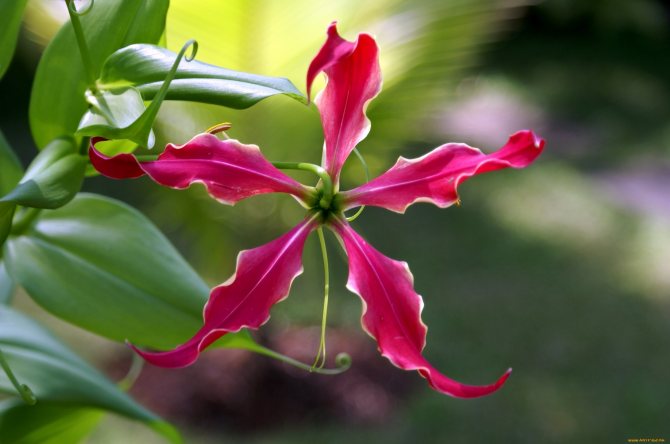

Top dressing and fertilization
The gloriosa flower feels great in soils that are rich in nutrients. To do this, mix humus with leafy earth in a 2: 1 combination. It is advisable to place a peat or sand additive in the substrate.
The plant is fed twice monthly. In this case, mineral additives and organic matter should alternate.
So that feeding and fertilization does not lead to empty results, attention should be paid to the soil before planting or transplanting. Leafy humus soil with the addition of peat and sand in proportions of 2: 1 is ideal. Drainage is recommended to avoid root rot. Stones, such as expanded clay or pebbles, are added under the soil layer, and then soil is added.
Gloriosa prefers liquid organic and mineral fertilizers. Alternatively, fertilizer for indoor plants "Ideal", "Uniflo - bud". Divorced according to the instructions. Florists recommend alternating mineral dressing for domestic plants with the same mullein infusion or bird droppings. The soil is fertilized in the spring every two weeks.
Pruning
It is recommended to maintain compactness and restrain, if necessary, the growth of the vines not by pruning, but by the timely direction of the shoots in the right direction or down around the support, since pruning their tops will negatively affect, first of all, on flowering, because the buds are formed in this part. It is possible to change the direction of growth of shoots only at their very young age and with great care due to their high fragility.
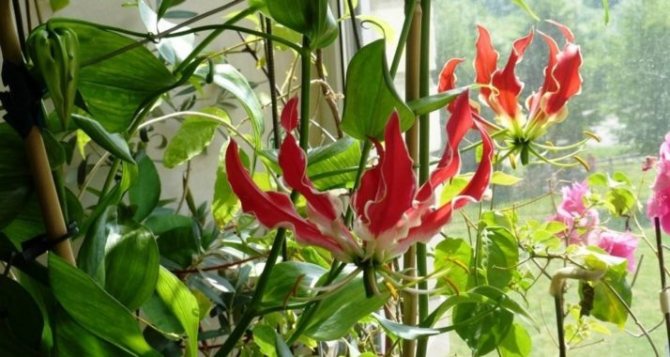

Benefits of Gloriosa
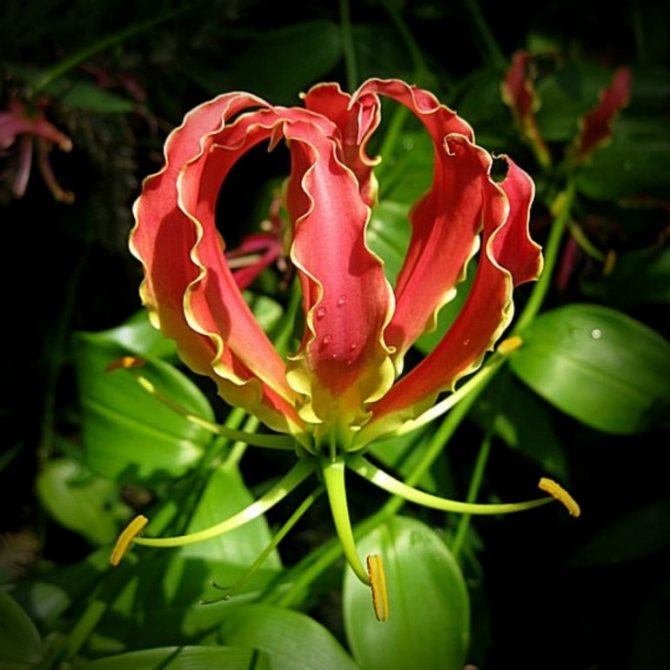

Gloriosa is a poisonous plant. The aerial part and root of the flower contains the alkaloid colchicine, the minimum dose of which - only 0.006 g - can cause fatal poisoning. But homeopaths and pharmacologists benefit from toxic substances.
Colchicine, which damages the kidneys and has a detrimental effect on vision, in the correct dose and in combination with the necessary components, prevents cell division, reduces the production of uric acid. A competently used substance helps to cope with the symptoms of gout, is used to prevent amyloidosis.
In conclusion
"Queen of lianas" or fire gloriosa - a bright decoration of any garden or vegetable corner in the apartment. She is not whimsical, but requires strict adherence to the rules and regulations of care.
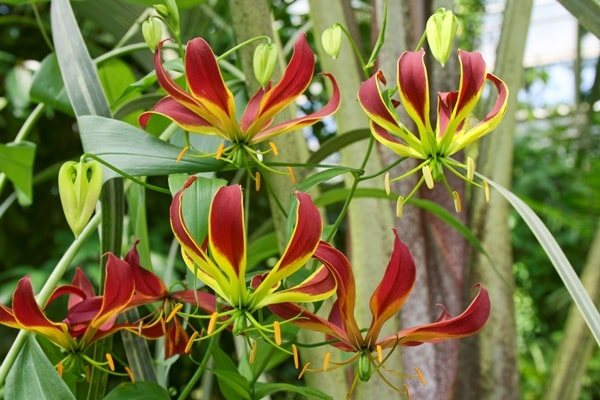

Despite its poisonous properties, the plant is used in folk medicine in India, Asia and Africa. There are also preparations based on gloriosa superba (magnificent gloriosa). With the help of herbal ingredients, there is complex treatment and prevention of inflammation, gout and tumors... A colorful bouquet of gloriosa will complement the bride's wedding image or delight a woman no worse than a bouquet of roses. People say that flowers not only kill, but heal and cheer up.
Gloriosa species suitable for home cultivation
In indoor culture, the most common species is known - luxurious or magnificent gloriosa (lat.Gloriosa superba), brought from India. Amateurs grow several varieties and varieties of this plant, which differ in appearance.
The most popular ones are:
Gloriosa Rothschildiana (Latin Gloriosa Rothschildiana) is characterized by an unusually large size. The stem is more than 2 m, and the flowers have petals half yellow, and in the center are red-crimson.
Gloriosa Luxurious yellow (Latin Gloriosa Lutea): a low variety, with bright lemon flowers.
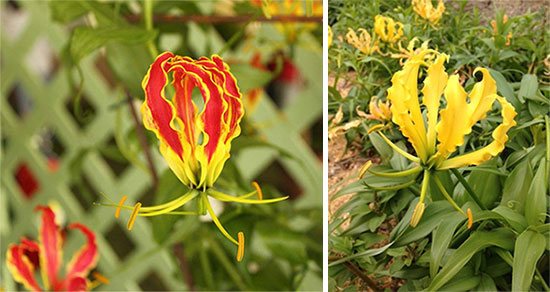

G. Rothschild, G. yellow
Gloriosa Carsonii (lat.Gloriosa Carsonii): a stocky variety, small, but striking color of a flower with a chocolate-purple center and a lemon-yellow edge.
Gloriosa Luxurious Grena (lat. Gloriosa Greenii): interesting in that bright yellow flowers have a surface that is not corrugated, but absolutely smooth. Wrapped outward, they resemble exotic Chinese lanterns.
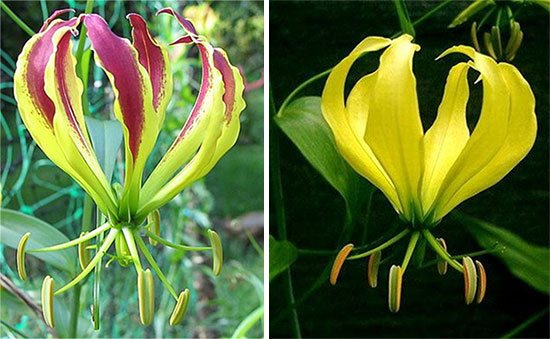

G. Carsoni, G. Grena
Professional florists can also get acquainted with other types, for example
Gloriosa modesta (Latin Gloriosa modesta), originally from South Africa. Liana 1-2m high, with yellow-orange drooping flowers. Petals are smooth and lanceolate. The leaves are lanceolate-ovate.
Gloriosa yellow-green (Latin Gloriosa flavovirens), endemic from Angola. Quite a crumb, reaching only 30cm.
Gloriosa flower: reproduction
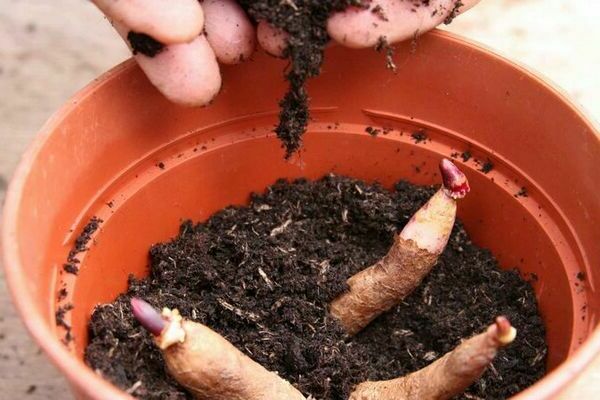

Gloriosa: reproduction by tubers
The most commonly practiced reproduction of Gloriosa tubers however, some growers prefer seed propagation. Since the first method is much more common and preferable, then let's start with it.
For disembarkation, you will need to pick up a small pot with a diameter of thirteen centimeters.The soil mixture here must be used not at all the same as in the previous case, and therefore it will be made from the following ingredients: leaf earth, sod soil, humus and sand. All this is thoroughly mixed in proportions of four to four to two to one.
In order for the tuber not to encounter any problems with germination, it must be directed vertically upward by the bud. There should be about three centimeters of earth above the kidney. It is also very important to keep the growing sprout warm. The temperature should be maintained at around twenty-two degrees Celsius.
It is highly recommended to use a bottom heater to retain heat. No watering is carried out in advance - it is done only when the sprout appears from under the ground. They, as already mentioned above, will definitely need to be tied to a stable support, because at first the leaves will not form and Gloriosa will have nothing to cling to.
Over time, the roots of the flower will grow so much that they will no longer fit in a temporary container. In this case, you need to transplant it as soon as possible into a more spacious housing.
What about breeding seeds, it is a very long and incredibly ineffective process. To begin with, the very process of obtaining seeds is already a test for many novice gardeners, because for this you will have to carry out a procedure that some will hear about for the first time: artificial pollination.
At the same time, seeds can be planted exclusively freshly harvested. And, of course, the seeds already planted in the ground need an eye and an eye, because they are incredibly tender, and with the slightest non-observance of the temperature regime or with insufficient watering, you can get an incredibly low percentage of germination.
So we can recommend the propagation of Gloriosa by seeds, exclusively as an interesting experiment or as a test of your skills.
Main types
Gloriosa superba
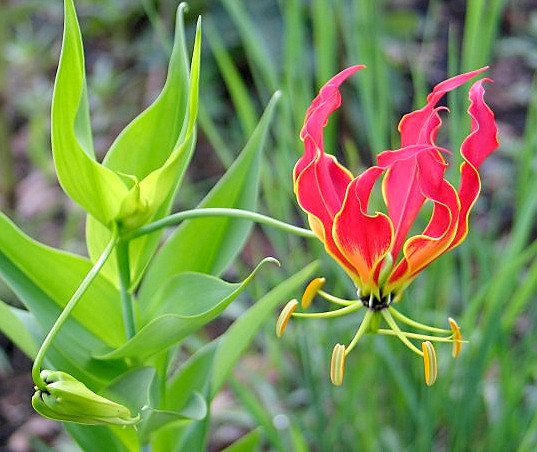

This species has many other names Gloriosa rothschildiana, Gloriosa abyssinica, Gloriosa virescens, Clinostylis speciosa, Gloriosa simplex and others. This is the most popular species in home floriculture, distinguished by its decorative effect. In nature, this kind can be found in Nepal, Sri Lanka, in the tropical regions of Africa and on the Malabar coast (at an altitude of up to 1500 meters). It prefers to grow on clay soils in monsoon and rain forests. The stems can reach a height of 150-200 centimeters. Glossy elongated-lanceolate leaves, pointed towards the apex, grow in three pieces and are alternately located. They reach 10 centimeters in length and 3 centimeters in width. Axillary flowers have wrinkled long petals (up to 8 centimeters long and up to 2.5 centimeters wide). They have an unusual color, for example, from the bottom inside they are yellow, from the top - a deep red color, and the outside is pinkish salmon. Blooms from June to August.
Gloriosa simplex
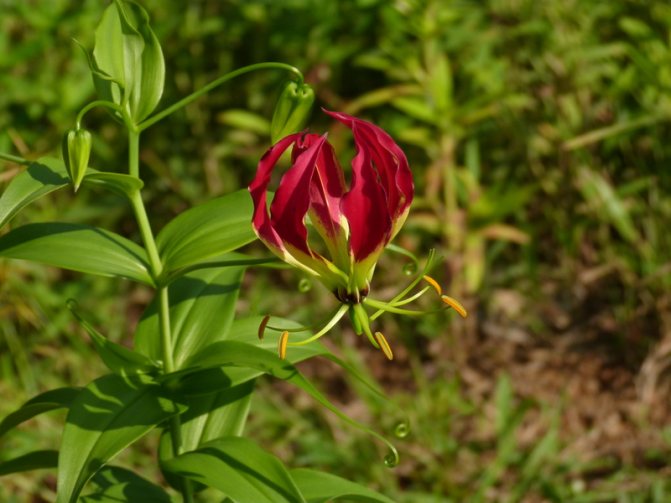

In nature, it is found in the humid forests of tropical regions of Africa. The stems can be up to 150 centimeters long. Lanceolate leaves reach 8 centimeters in length. Smooth, slightly wavy flowers grow from the leaf sinuses. Non-bent petals are up to 5 centimeters long, they are painted green-yellow with a yellow-red tint. It blooms very profusely in the summer.
Gloriosa Rothschild (Gloriosa rothschildiana)
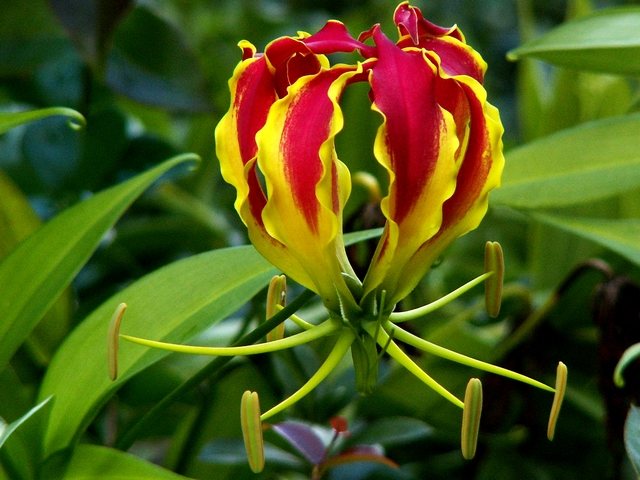

In nature, it is found in the humid forests of tropical regions of Africa. The curly stems are straight at first and then branch out. Lanceolate leaves grow up to 8 centimeters long. The flowers grow from the sinuses and attach to very long pedicels (up to 10 centimeters). Lanceolate petals reach 10 centimeters in length, while the edges of the petals are wavy and have a bend. The flowers are dark red and have purple specks underneath. Blooms in the summer. The Citrina variety differs in that it has a dark red pattern on its lemon-colored petals.
Garter to supports
Despite the subtlety, the vine shoots are fragile enough, which is why they are not able to wrap around the supports, they need help. The antennae of the leaves partly take on this load, but it is completely unbearable for them, in addition, the antennae are absent on the lower tiers of the leaves. An initial liana garter is needed, after which it can already cope on its own. To fix the antennae, rather thin wire-type crossbars are needed, they will not be able to catch on a thick rod. With a solid weight, the vines must be supported and tied up constantly, while simultaneously setting the direction angle. If you put a thin wire or wooden ladder next to the container or stick it into it, then the plant will cope on its own.

